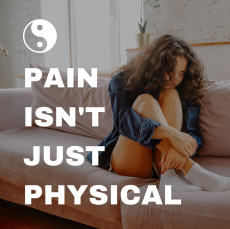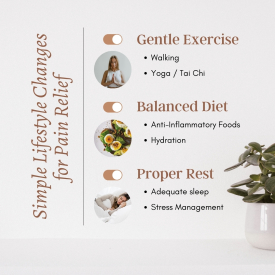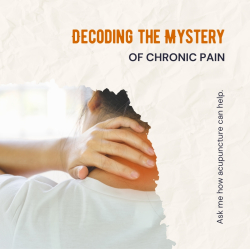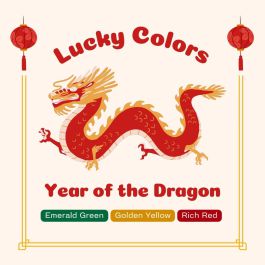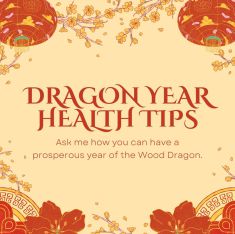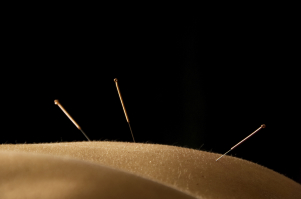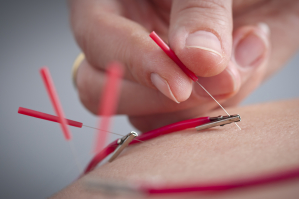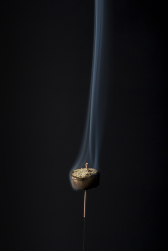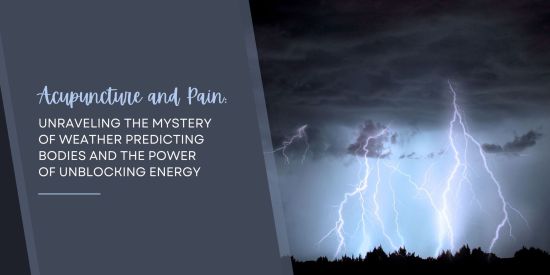
Acupuncture Newsletter
Can Acupuncture Help My Seasonal Allergies?
Allergies, seasonal or year-round, are an ongoing problem for many individuals. Seasonal allergies typically affect people during a particular season or time of year. They are also referred to as outdoor allergies and are generally triggered by tree, grass and weed pollens or outdoor mold spores. Year-round allergies, also known as indoor allergies, are typically brought on by animal dander, dust mites, mold spores or insect allergens. There are also food allergies, which occur as a result of eating a culprit food and can create physical and/or emotional symptoms such as body hives, swelling, itching or redness of the skin, depression and/or moodiness.
No matter what kind of allergy you suffer from, environmental or food related, acupuncture can provide needed relief. While medications (over-the-counter or prescribed) often come with unwanted side-effects, acupuncture does not. This makes acupuncture an appealing option for people looking for a new way to combat allergies.
According to Chinese medical theory, the symptoms and signs that indicate a Western diagnosis of allergies relate to imbalances in the meridian and Organ Systems of the body. These imbalances may stem from a variety of causes, including stress, poor diet, foods that don’t agree with your body, constitutional weakness, pollutants and environmental toxins.
Over time, if imbalances remain within the body, they will affect the functions of the Organ Systems. Some of these Organ Systems are involved in the production of Wei Qi (pronounced “way chee”). According to the theories of acupuncture and Chinese medicine, it is important to have the correct quality and quantity of Wei Qi circulating around the body in order to stay healthy.
What is Wei Qi? The Chinese concept of Wei Qi is similar to the Western concept of the immune system. Wei Qi functions to protect and defend the body against foreign substances, that if not caught can lead to allergies. When Wei Qi is strong and abundant, we remain healthy. When the supply of Wei Qi becomes deficient, health is compromised and we become vulnerable to foreign invaders such as dust, mold, animal dander, bacteria, viruses and pollen. People who have a Wei Qi deficiency are prone to allergies and frequent colds.
Acupuncture and Chinese medicine support and strengthen the systems of the body that are involved in the production of Wei Qi. By building up the supply of Wei Qi and facilitating the smooth and free flow of it through the body, symptoms and signs related to allergies could be greatly reduced or eliminated.
What will an acupuncturist do? An acupuncturist will conduct a thorough exam, taking a complete health history. They will then develop a unique treatment plan that will address your specific concerns. The goals of the treatment plan will be to eliminate visible symptoms and signs, while addressing the root cause(s) and underlying imbalances affecting the quality and quantity of Wei Qi.
Acupuncture treatments may be combined with herbs, dietary changes, massage (tuina), or exercise. These therapies accelerate the healing process in order to balance, build, and support the health and functioning of your body’s systems.
Acupuncture and Chinese medicine are a drug-free, safe, natural and effective way to eliminate hay fever, allergies or the common cold.
Seasonal allergy tips:
- Flush your nose with a Neti pot.
- Add spicy foods and omega-3’s to your diet.
- Keep your windows closed during allergy season to prevent dust and pollen from entering.
- Put on a dust mask when you are doing yard or housework.
- Do not hang your clothes out to dry in the sun, as they will gather dust, mold and pollen.
- Come in for an acupuncture tune-up.
If you suffer from food allergies:
- See an allergist and get tested for a proper diagnosis of a food allergy.
- Avoid the foods that cause your reaction.
- Peanuts, the proteins in cow’s milk, shellfish, tree nuts, fish, eggs, gluten, wheat and soy are the most common food allergens.
- It is possible to outgrow some food allergies.
- Ask about ingredients at restaurants or when eating food prepared by another person.
- Read food labels carefully.
Allergies according to Traditional Chinese Medicine (TCM) can be due to a variety of factors. Below are some of the more common TCM diagnoses that your acupuncturist may discover and treat.
- Wei Qi deficiency
- Spleen weakness
- Kidney deficiency
- Lung deficiency
A Personalized Acupuncture Approach to Pain and Chronic Pain
Discover Your Unique Path to Managing Pain and Chronic Pain with Acupuncture
In the realm of managing pain and chronic pain, acupuncture offers a distinctly personalized approach. Unlike the more general treatments typical in Western medicine, acupuncture delves into your individual symptoms and history. This enables us to craft a diagnosis and treatment plan that is uniquely yours. Let's delve into how different symptoms lead to specific diagnoses in Traditional Chinese Medicine (TCM).
Beyond One-Size-Fits-All
In TCM, pain and chronic pain aren't just broad categories; they are complex conditions shaped by your individual symptoms and life experiences. By understanding your specific manifestations of pain, we can arrive at a more accurate TCM diagnosis, leading to a more effective and personalized treatment plan.
Different TCM Diagnosis for Pain and Chronic Pain
1. Qi Stagnation: Often associated with pain that moves around, feeling of tension, and emotional fluctuations. This diagnosis relates to the blockage of Qi, or life energy, especially in areas affected by pain.
2. Blood Stasis: Characterized by sharp, stabbing pain in a fixed location, possibly a result of an old injury or chronic condition. This reflects a disruption in blood circulation, essential for pain relief.
3. Cold-Damp Accumulation: Seen in pain that worsens in cold, damp weather, accompanied by feelings of heaviness and numbness. It indicates an excess of cold and damp elements in the body, affecting the flow of Qi.
4. Deficiency Conditions: Identified in cases of dull, lingering pain that improves with rest, linked to an overall weakness in the body's energy system. This points to a need for nourishing and strengthening the body.
5. Heat or Fire: Related to inflammation, redness, and swelling, this diagnosis is connected to an excess of heat in the body, often exacerbating pain symptoms.
Which Diagnosis Resonates with You?
As you read these descriptions, you might recognize symptoms that align with your experience. This reflection is an important step in your healing journey. Identifying the diagnosis that resonates most with your situation is key to developing a targeted treatment plan.
Unique Treatments for Unique Individuals
Based on your specific TCM diagnosis, we design a customized acupuncture plan. This could involve targeting particular points to alleviate Qi Stagnation or addressing Blood Stasis to improve circulation and relieve pain.
Alongside acupuncture, we offer lifestyle and dietary advice, herbal supplements, and other holistic practices to provide a comprehensive approach to managing your pain and chronic pain.
Ready to Discover Your Path?
Interested in finding out which TCM diagnosis aligns with your experience and how acupuncture can aid you? We invite you to book a free personalized consultation to explore your unique path to pain relief and overall wellness.
Together, let’s find the most effective route to your comfort and health.
Acupuncture Insights for Pain and Chronic Pain
In this edition, we're turning our attention to a prevalent and often debilitating issue: pain and chronic pain. We'll delve into how they affect our daily lives, and the remarkable role acupuncture plays in alleviating these conditions.
Understanding Pain and Chronic Pain
Pain and Chronic Pain in Our Lives: More than just discomfort, chronic pain can be a constant companion, affecting every aspect of life. It can limit mobility, disrupt sleep patterns, impact mental health, and even strain personal and professional relationships. Pain, in its persistent form, becomes a lens through which every experience is filtered.
The Impact of Pain and Chronic Pain
1. Mobility and Activity Limitations: Restricting daily movements and reducing quality of life.
2. Sleep Disturbances: Leading to fatigue and impacting overall health.
3. Mental Health Challenges: Increased risk of depression, anxiety, and stress.
4. Social and Work Impairments: Affecting personal interactions and professional productivity.
5. Worsening Overall Health: Chronic pain often coexists with other health issues, creating a compounded effect on well-being.
Acupuncture: A Proven Solution for Pain
Did You Know?
- Acupuncture, rooted in traditional Chinese medicine, involves stimulating specific points on the body, often using needles. It’s a practice that extends beyond mere pain relief; it aims to restore the body's balance and natural healing mechanisms, which can be disrupted by chronic pain.
- An acupuncturist doesn't just treat the symptoms; they look at one of six (or more) diagnoses to develop a precise treatment plan tailored to each person's unique condition. These diagnoses include Qi stagnation, blood stasis, cold-damp accumulation, heat or fire, deficiency conditions, and more, each with its specific set of symptoms and treatment approaches.
- Acupuncture can significantly reduce inflammation, a key contributor to chronic pain, and is known to improve blood circulation, aiding in the body’s natural healing process.
- Research in the "Journal of Pain Research" indicates that acupuncture can effectively treat various types of chronic pain, including arthritis and back pain. Source.
This added information emphasizes the thorough and personalized approach that acupuncturists take in diagnosing and treating pain, enhancing the reader's understanding of the depth and effectiveness of acupuncture as a treatment modality.
Fascinating Facts:
- Acupuncture can significantly reduce inflammation, a key contributor to chronic pain.
- It’s known to improve blood circulation, aiding in the body’s natural healing process.
- Research in the "Journal of Pain Research" indicates that acupuncture can be effective in treating various types of chronic pain, including arthritis and back pain. Source.
How Acupuncture Addresses Pain and Chronic Pain
1. Targeting Specific Points: Points like 'GB34' and 'LI4' are known for their effectiveness in pain relief.
2. Personalized Treatments: Each session is customized to address your unique pain patterns and concerns.
3. Holistic Healing: Acupuncture looks beyond the symptoms, targeting the root cause of pain and promoting overall health.
Taking the Next Step
Interested in Exploring Acupuncture for Pain and Chronic Pain?
- Discover more on our website or contact us to delve into how acupuncture can address your pain concerns.
- Schedule a consultation with our skilled practitioners to begin your tailored acupuncture journey.
As we confront the challenges posed by pain and chronic pain, having effective tools like acupuncture is essential. Whether you're exploring acupuncture for the first time or are familiar with its benefits, there's always something new to discover in this ancient yet dynamic healing practice.
Until our next newsletter, wishing you health and comfort!
Celebrating Chinese New Year 2024: Embracing the Year of the Dragon
As we recently celebrated the Chinese New Year of 2024, we welcome the dynamic and powerful Year of the Dragon – a symbol of strength, fortune, and auspiciousness in Chinese culture. The Dragon, revered for its boldness and confidence, brings with it a year of potential, success, and vitality.
The Dragon’s Influence on Success and Health
The Year of the Dragon is traditionally seen as a time of transformation and significant growth. For those seeking success in their personal and professional lives, this year encourages bold actions and big dreams. It's a period where taking risks can lead to substantial rewards, and where ambition is not just welcomed but necessary.
In terms of health, the Dragon year is a reminder to harness our inner strength and vitality. It’s an opportune time to focus on both physical and mental wellness, encouraging us to be proactive about our health. This might mean starting a new fitness regime, paying closer attention to our diets, or taking time to de-stress and recharge our mental batteries.
Tips for Success in the Dragon Year
1. Be Bold and Ambitious: The Dragon’s energy supports grand plans and big ideas. Don't shy away from setting ambitious goals or taking on challenging projects.
2. Embrace Change: Change is a constant companion of the Dragon. Be open to new opportunities and be ready to adapt to new circumstances.
3. Focus on Self-Improvement: Use this year to grow personally and professionally. Learn new skills, expand your knowledge, and push your boundaries.
4. Nurture Your Relationships: Dragons are known for their charisma and leadership. Foster your personal and professional relationships for support and collaboration.
5. Prioritize Your Health: Engage in activities that boost your physical strength and mental clarity. Remember, a healthy body is home to a successful spirit.
6. Practice Mindfulness: Amidst the Dragon’s energetic influence, find time for reflection and mindfulness to maintain balance.
As we celebrate the Chinese New Year of 2024, let us imbibe the Dragon’s spirited energy. May this year bring you the courage to chase your dreams, the strength to overcome challenges, and the wisdom to maintain balance in all aspects of life.
Happy Chinese New Year! May the Year of the Dragon be a prosperous and fulfilling one for you and your loved ones. ??
Unlock the Power of Wellness: The Benefits of Acupuncture and Why You Should Share the News
In our fast-paced world, maintaining optimal health and well-being is a priority. Acupuncture, a traditional Chinese medical practice, is gaining traction as a holistic and effective treatment for a myriad of health issues. Let's dive into the profound benefits of acupuncture and explore why it's essential to share this enlightening information with friends and family.
The Myriad Benefits of Acupuncture:
1. Alleviates Chronic Pain:
- Experience relief from chronic ailments such as back pain, arthritis, and migraines.
2. Reduces Stress and Anxiety:
- Harmonize your mind and body, lowering stress and anxiety levels for a calmer, more balanced you.
3. Enhances Immune System:
- Fortify your immune system, bolstering your body's defense against illnesses.
4. Improves Sleep Quality:
- Overcome insomnia and enjoy restful, rejuvenating sleep, empowering you to tackle each day with renewed vitality.
5. Offers Allergy Relief:
- Say goodbye to allergies by strengthening your body’s resilience to environmental irritants.
6. Supports Mental Focus and Clarity:
- Sharpen your mental focus and clarity, enhancing productivity and mental well-being.
7. Mitigates Digestive Issues:
- Improve your digestive health, fostering better nutrient absorption and overall wellness.
The Power of Sharing:
Educating our friends and family about acupuncture's remarkable benefits is a step towards a healthier, more balanced community. Sharing this information:
- Empowers individuals to make informed health decisions.
- Debunks myths and uncertainties about acupuncture.
- Encourages a proactive approach to personal well-being.
- Cultivates a supportive community centered on health and wellness.
Why Choose a Qualified and Certified Acupuncturist:
It's crucial to choose a qualified and certified acupuncturist to ensure safe and effective treatment. Acupuncturists undergo extensive training, including four years of schooling and rigorous examinations, guaranteeing they have the comprehensive knowledge and skills to provide exceptional care.
As we embrace the holistic healing of acupuncture, let's unite in spreading the word about its transformative benefits. Read, learn, and share this newsletter with friends and family, fostering a community enriched with wellness and vitality. Your journey to optimal health and well-being is a shared adventure. Let's embark on this path together, celebrating the gift of acupuncture and its bounteous blessings for our health and lives.
Embark on your wellness journey today! Schedule an acupuncture session and experience the abundance of health benefits it offers. Share the wellness. Share the healing. Share the love.
In 1991, a famous Japanese moxa therapist and researcher, Dr Shimetaro Hara, died at the age of 108, holding the official title of oldest male in Japan at the time. He was a proponent of regular moxa use for immunity and longevity. He studied the effects of moxa on white and red blood cell counts. During the 1930s, before antibiotics, he was using moxibustion in Japan to treat many severe illnesses, including TB, with great success he credited to improved immunity.
The word Moxa comes from a Western misspelling of the Japanese term ‘Mogusa’ (herb that burns) and refers to dried mugwort. Moxibustion is the burning of moxa. Mugwort gets its botanical name, Artemisia, from the Greek goddess Artemis, a patron of women, and just happens to be a wonderful herb for gynecological conditions, among many other uses. One of its most famous applications is when moxibustion is used to turn breech babies into a normal head-down position before childbirth. Moxibustion on a point on the pinky toe (BL-67) is well known for correcting abnormal fetal position and success rates are significantly higher than reports of manual manipulation.
All over the world, this herb has been recognized for its medicinal and mystical powers. In Europe, mugwort was left under doormats to ward off unwelcome guests. Native North Americans used the smoke for purification purposes. Ancient Romans planted mugwort along roadsides to offer relief to soldiers on long marches (who would put it in their boots).
As far as medicinal applications in China, there are theories that it predates acupuncture. There are records of it being used as far back as the Shang Dynasty (16th century BCE). The Chinese word for acupuncture is Zhenjiu, which literally translates to needling (zhen) and moxibustion (jiu). So, it has definitely enjoyed a long close history with the practice of needling.
So, how does moxibustion work?
Modern research of the moxibustion mechanism mainly looks at thermal, radiation, and pharmacological actions The basic idea is that when burned, moxa releases infrared heat and volatile oils. The white fur on the underside of the mugwort leaf contains aromatic oils. These oils, borneol and cineol, specifically, may account for the pharmacological effects of moxa. Tinctures and topical applications made of mugwort are used to treat many conditions because of the therapeutic and antibacterial properties of the essential oils and tannins in the leaves. The higher the grade of moxa, the more essential oils it contains.
There is debate as to whether current applications (which do not involve direct contact with the burning moxa, unlike more traditional practices of ‘scarring moxa’) allow for a strong enough transmission of the benefits of the essential oils. However, the value of moxibustion as one of the oldest infrared healing therapies continues to be appreciated and explored. One understanding is that meridians are like optical fibers that transmit infrared radiation. An interesting example of this theory in motion is a study where moxibustion on LI-4, a point on the hand, significantly improved temperature asymmetry in the faces of Bell's palsy patients. The temperature change was strongest around the lips, interestingly near the facial pathway of the channel being stimulated on the hand.
If you ask an acupuncturist what it does, you may hear expressions like:
“It imparts yang qi to the body”, or “it warms and promotes qi and blood circulation”. It is considered tonifying and invigorating and commonly used in clinics for many chronic conditions such as immune and digestive issues, cold conditions and fatigue.
Regardless of mechanisms of action, the merits of moxibustion have been confirmed by science. Research supports beneficial effects on immunity, inflammation, pain, the kidneys, colitis, ulcers, neurons, and gene expression. In one study demonstrating immune boosting effects in an elderly population, daily treatment for 10 days with moxa applied to the needles at acupuncture point ST-36 showed enhanced production of IL-2, an important immune-regulating molecule.
The same point used in that study, ST-36, on the upper shin, is a point many acupuncturists use on patients and themselves with moxibustion to tonify digestion, build blood and boost immunity. Dr. Hara, the Japanese moxa researcher, more than likely had a regular practice of applying moxa to this point, and it may be what helped him live to the ripe age of 108!
While not all acupuncture clinics use moxibustion due to concerns with smoke, mugwort is a cornerstone herb of Chinese healing practices. Call your acupuncturist today to find out ways it can be incorporated into your treatments and/or self-care practices!
Acupuncture and Pain: Unraveling the Mystery of Weather Predicting Bodies and the Power of Unblocking Energy
Acupuncture, an integral part of Traditional Chinese Medicine (TCM), has been practiced for thousands of years. It is increasingly gaining recognition in Western medicine for its effectiveness in treating various types of pain. The philosophy of acupuncture is rooted in the principles of bi-syndrome, stagnation, and the body's unique and surprising ability to predict weather changes. Let's delve into these fascinating aspects of acupuncture and understand how they contribute to pain management.
Acupuncture: A Primer
Acupuncture involves the insertion of very thin needles at specific points in the body, known as acupoints. This is done to regulate the flow of 'Qi' (pronounced "chee") or life force energy, thereby promoting healing and wellness. When Qi flows freely, we experience good health. When it's blocked or disrupted, we experience illness or pain. This is where the concepts of bi-syndrome and stagnation come in.
Understanding Bi-Syndrome
In TCM, bi-syndrome refers to a group of symptoms that are typically associated with pain, numbness, heaviness, and swelling in the muscles, tendons, bones, and joints. The term 'bi' means obstruction, and it's believed that bi-syndrome occurs when Qi and blood circulation in the meridians (energy channels) are blocked. Weather changes, particularly cold, dampness, and wind, are considered significant factors in causing bi-syndrome.
By using acupuncture to stimulate specific acupoints, we can help to unblock the Qi, improve circulation, and alleviate the symptoms of bi-syndrome.
Stagnation and Its Role in Pain
Stagnation in TCM is associated with the concept that pain is the result of blocked or stagnant Qi or blood. When the free flow of these vital substances is impeded, it can lead to pain. This concept is similar to the way Western medicine understands that poor blood flow can lead to tissue damage and pain.
Acupuncture's role in treating stagnation-related pain involves the stimulation of acupoints to restore the free flow of Qi and blood. This action reduces pain and promotes healing.
Our Body: The Weather Vane
Have you ever noticed how some people claim they can predict the weather based on their joint pain? It turns out, this isn't just an old wives' tale. Changes in atmospheric pressure, temperature, and humidity can indeed affect our bodies, particularly those suffering from chronic pain conditions like arthritis. This phenomenon is closely linked to the concept of bi-syndrome in TCM.
As the weather changes, those with bi-syndrome might experience exacerbated symptoms due to the Qi and blood in their bodies becoming more blocked. Acupuncture, therefore, can play a significant role in mitigating these weather-related pain flare-ups by maintaining the smooth flow of Qi and blood.
Acupuncture offers a unique and natural approach to pain management, embracing concepts like bi-syndrome and stagnation and acknowledging the profound interconnectedness between our bodies and the environment. By unblocking Qi and promoting the free flow of energy, acupuncture not only provides relief from pain but also helps us better understand and tune into our bodies.
If you've been struggling with chronic or weather-related pain, or know someone who is, consider giving acupuncture a try.
Your body - and your peace of mind - might thank you for it.
For more articles and resources, read our blog and subscribe to our channels!







